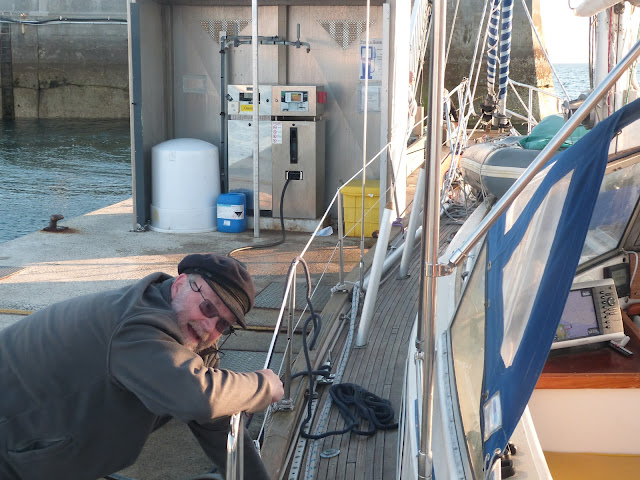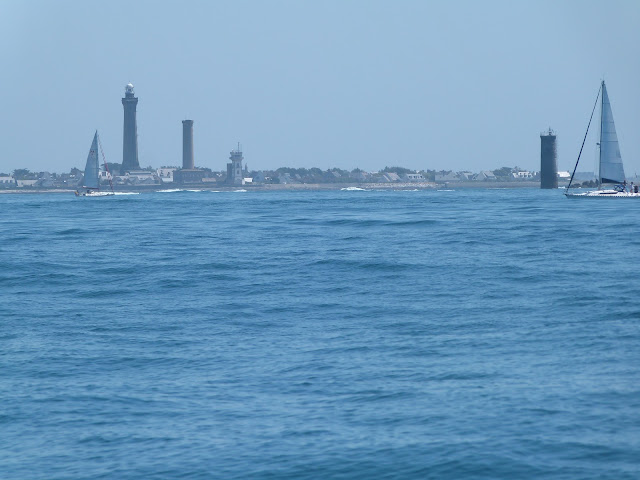We arrive in the Scillies at 3 am and awake to bright sunshine. Quickly hoist a multipurpose Celtic Nations flag to honour the Cornish nation (best I can do as regards a courtesy flag)
Some shots of the narrow sound of New Grimbsby, between the Islands of Tresco and Bryher.Below is the Beach on Tresco, the island has a beautiful garden and a nice pub with rooms (hint - worth a stay!) also self catering, but numbers are small, few cars, a few buggies, feels a bit like "the Prisoner", but no sign of Patrick Magoohan (number six)
Locals make money as many ways as they can
So, after fish and chips, a beer, a bit of a walk and a chill on the boat we go to bed to catch the early tide the next morning - you need half tide to cross the shallows to get south so we rise at 6:30 and head at 7 am for France. Wind starts light but comes up to a nice force 4.
We blast across the channel - the first two thirds are at 7 to 8 knots, we could have made a real record crossing as we are on a perfect beam reach heading for West of the Island of Ushant (Ouessant as the French call it). We could have anchored or gone on moorings on a bay on the Island but the swell in the channel is really quite big and we decide that Ushant is unwise - it is described as somewhere to visit in fair weather.
A pity as I have sailed past it 4 or 5 times - I usually stop in L'AberWrac'h a nice village on the North French coast about 10 miles from the corner which heads South. The route south is down the Chenel du Four - a nasty place to be in a gale because of strong currents fighting with the wind - but a pussy cat if the tides are just right and the currents slack.
So we alter course from that perfect beam reach to a more rolly broad reach and speed drops to 5 to 6 knots. Still a respectable speed and I calculate we can make the Chenel du Four with tide in our favour, not slack but at least pushing us south, and wind with tide is usually ok, wind against tide produces horrible breaking seas.
So we push on through the Chenel and get into Camaret at 2 in the morning (British time). We wake again to blue skies and bright sunshine - which basically is the weather for the next week!
The Video below might not play on Apple products, call back in a few days and I will add a youtube link for you. If on windows, you can click the button on the bottom right once the video starts playing to get full screen more, hit the ESC key to exit full screen.
The original church was built in 1467 but that might be as old as a ballymena hammer that has had its shaft replaced three times and its head replaced twice.
I notice the sailing school has youngsters out and I caught this shot of young kids and their wee toys and older kids and their big toy - the trimaran has no-one aboard that looks over 20!
Next moring at 7am we get fuel from the self service, credit card machine on the pontoon and off we go to Les Glenans
The first obstacles are the very pretty rocks - you go between them if heading South, which Shirley and I had done in Otago our previous boat in the early 2000's
I do like light houses. I wish I could have photographed the 20 lights we saw around the horizon and midnight the night before going down the Chenel du Four. The next tidal gate, south of Camaret is the Raz de Sein - even worse tides here but fewer rocks. This is the first lighthouse at the Raz - Tevennec light.
Other lights are Le Chat
La Platte (Yellow - Black - Yellow) and LE Vieille
By the way you can use proper nautical charts online - at https://webapp.navionics.com/ to see the areas we are sailing through, and follow us at https://www.marinetraffic.com/
After the Raz, with a dying wind (again) we motor 25 miles south to the Point de Pen'March
It has nice lighthouses too! (maybe when I am old I will record all the lighthouses in France, or the UK - would be a nice project - for when I am old(er).
The AIS (Automatic Identification System) Identifies a boat that will attempt to occupy the same space at the same time as Shadowmere. We make a minor alteration of course (despite being in the right. People that insist on their right of way are sometimes right, dead right...)
And the Glenans finally approach
These are a collection of very low lying islands that have very shallow water, we pick up a mooring in 9 feet of water and I go swimming to look at the prop, get clean and test a rope ladder I made - a double figure of eight at the bottom and then alpine butterfly knots every 12 inches or so. The Alpine butteryfly knot is a climbing knot not known by many sailors. Worth looking up! go Google or Youtube - https://youtu.com
There are many islands, the main one has ferries that bring in day trippers. The islands also host sail training, in fact the biggest sail training in France, perhaps Europe - 15,000 students a year, the Glenan methods are so good that other Glenan Schools have opened - I think there is one in Ireland at Bearhaven. I studied a Glenans text many years ago. They teach initial navigation only using a chart and a piece of string. France in general is superb in the way it teaches it's kids to sail. I think every child, or maybe every child of a coastal department must do a learn to sail course. I wish our country would do this. Learning to sail is not about sailing, it is about self reliance, trust, dealing with success and failure, being responsible for your own destiny and learning how to live... <rant mode off>
Moorings are a bit tight
The narrow stretch of sand between these two islands hosts barbecues and beach games,
Here is a a shot of one of the islands that runs sailing courses - look at the masts. By the way the boats are all pretty new, fast, exciting catamarans or some monohulls Excite the kids and they learn as a side effect of their having fun.
After the Glenans we head down the french islands, We pass the Isle de Groix without visiting because by pressing on we can make Belle Isle.



























No comments:
Post a Comment
Note: only a member of this blog may post a comment.